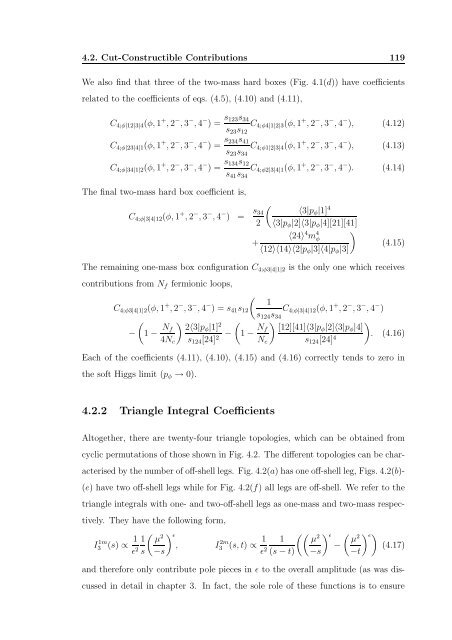Hadronic production of a Higgs boson in association with two jets at ...
Hadronic production of a Higgs boson in association with two jets at ...
Hadronic production of a Higgs boson in association with two jets at ...
Create successful ePaper yourself
Turn your PDF publications into a flip-book with our unique Google optimized e-Paper software.
4.2. Cut-Constructible Contributions 119We also f<strong>in</strong>d th<strong>at</strong> three <strong>of</strong> the <strong>two</strong>-mass hard boxes (Fig. 4.1(d)) have coefficientsrel<strong>at</strong>ed to the coefficients <strong>of</strong> eqs. (4.5), (4.10) and (4.11),C 4;φ|12|3|4 (φ, 1 + , 2 − , 3 − , 4 − ) = s 123s 34s 23 s 12C 4;φ4|1|2|3 (φ, 1 + , 2 − , 3 − , 4 − ), (4.12)C 4;φ|23|4|1 (φ, 1 + , 2 − , 3 − , 4 − ) = s 234s 41s 23 s 34C 4;φ1|2|3|4 (φ, 1 + , 2 − , 3 − , 4 − ), (4.13)C 4;φ|34|1|2 (φ, 1 + , 2 − , 3 − , 4 − ) = s 134s 12s 41 s 34C 4;φ2|3|4|1 (φ, 1 + , 2 − , 3 − , 4 − ). (4.14)The f<strong>in</strong>al <strong>two</strong>-mass hard box coefficient is,C 4;φ|3|4|12 (φ, 1 + , 2 − , 3 − , 4 − ) = s (34 〈3|p φ |1] 42 〈3|p φ |2]〈3|p φ |4][21][41]〈24〉 4 m 4 )φ+〈12〉〈14〉〈2|p φ |3]〈4|p φ |3](4.15)The rema<strong>in</strong><strong>in</strong>g one-mass box configur<strong>at</strong>ion C 4;φ3|4|1|2 is the only one which receivescontributions from N f fermionic loops,( 1C 4;φ3|4|1|2 (φ, 1 + , 2 − , 3 − , 4 − ) = s 41 s 12 C 4;φ|3|4|12 (φ, 1 + , 2 − , 3 − , 4 − )s 124 s 34(− 1 − N ) (f 2〈3|pφ |1] 24N c s 124 [24] − 1 − N ) )f [12][41]〈3|pφ |2]〈3|p φ |4]. (4.16)2 N c s 124 [24] 4Each <strong>of</strong> the coefficients (4.11), (4.10), (4.15) and (4.16) correctly tends to zero <strong>in</strong>the s<strong>of</strong>t <strong>Higgs</strong> limit (p φ → 0).4.2.2 Triangle Integral CoefficientsAltogether, there are twenty-four triangle topologies, which can be obta<strong>in</strong>ed fromcyclic permut<strong>at</strong>ions <strong>of</strong> those shown <strong>in</strong> Fig. 4.2. The different topologies can be characterisedby the number <strong>of</strong> <strong>of</strong>f-shell legs. Fig. 4.2(a) has one <strong>of</strong>f-shell leg, Figs. 4.2(b)-(e) have <strong>two</strong> <strong>of</strong>f-shell legs while for Fig. 4.2(f) all legs are <strong>of</strong>f-shell. We refer to thetriangle <strong>in</strong>tegrals <strong>with</strong> one- and <strong>two</strong>-<strong>of</strong>f-shell legs as one-mass and <strong>two</strong>-mass respectively.They have the follow<strong>in</strong>g form,I3 1m (s) ∝ 1 ( )1 µ2 ǫ, Iǫ 2 3 2m (s, t) ∝ 1 (( )1 µ2 ǫ ( ) µ2 ǫ )− (4.17)s −sǫ 2 (s − t) −s −tand therefore only contribute pole pieces <strong>in</strong> ǫ to the overall amplitude (as was discussed<strong>in</strong> detail <strong>in</strong> chapter 3. In fact, the sole role <strong>of</strong> these functions is to ensure
















